The post 5 Tips to Prevent Headaches and Migraines appeared first on MetaMed.
]]>Headaches and migraines aren't just a pain in the head. They're a pain in the butt. Suffering from daily, weekly or even random headaches can significantly interfere with your day and ability to do simple tasks.
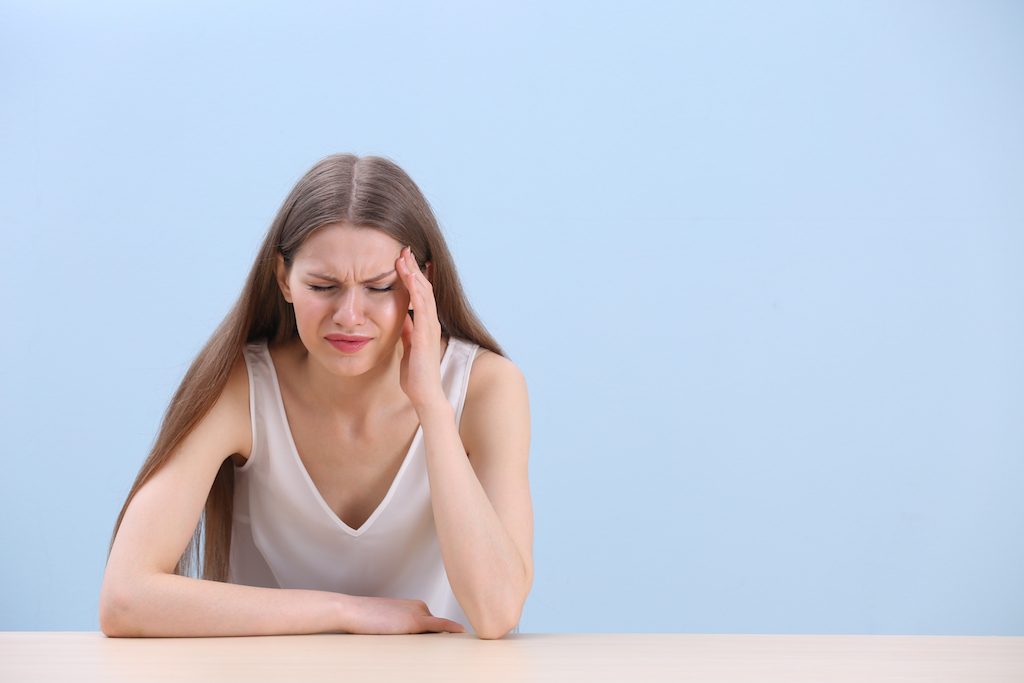
Headaches and Migraines Can Affect Your:
- Ability to work
- Focus
- Decision making
- Ability to look after your kids
Although headaches and migraines are slightly different (see our post on Migraines) there are some basic tips to help prevent and manage them.

Top 5 Tips to Prevent Headaches and Migraines:
- Keep your hydration up. Drinking at least 2 litres of water per day. If you have difficulty drinking water you can try sparkling water, a squeeze of lemon, or drinking non-caffeinated herbal teas. Herbal teas are a great option during the cooler months. Try peppermint, berry teas or relaxing blends. Avoid sweetened drinks, soft drinks or energy drinks.
- Eat regular and small healthy snacks and meals. This helps to keep your blood sugar levels up and help sustain energy. Keep sugar content down in your snacks and meals to avoid a sugar crash and tiredness later. High-fat snacks such as avocado, salmon, nuts. It is also a good idea to identify if you have any particular foods that trigger headaches or migraines and avoid these.
- Regulate your sleep and wake times (read our blog post on Benefits of Regulating Your Sleep Cycle). Sleep is an important part of winding down from your day and repairing from any stressors you may have encountered. Try and go to bed by 10pm and avoid screen time for 30- 60 minutes before bed.
- Stress relief. Finding ways to let go of daily stress helps relieve muscle tension and wind down for a peaceful nights sleep. Meditation is one way. Going to a yoga or exercise class is another. If you have difficulty meditating there are guided meditation apps with some great sleep stories, such as Calm App.
- Magnesium supplements are great for relaxing muscle tension and calming your nervous system and can aid with reducing frequency and intensity of headaches and migraines. Read more about Magnesium types and doses here.
We are here to help
The post 5 Tips to Prevent Headaches and Migraines appeared first on MetaMed.
]]>The post Arthritic Neck: Chiropractor or Osteopath for neck pain appeared first on MetaMed.
]]>Have You Been Told You Have Arthritis in Your Neck?
Arthritis is another word for:
- degeneration
- wear and tear
We often find that people who have a stiff and sore neck are being told they have arthritis, and there is nothing you can do about it. That it's just part of ageing. True that it's part of ageing, but not true that you can't do anything about the pain! Especially if you haven't tried hands-on treatment.
You may have been referred for x-rays which show a little bit of joint space narrowing and words used such as spurs or osteophytes (little bony growths). But the images of your neck don't necessarily correlate with your level of discomfort, AND x-rays only show us the state of your bones. What it doesn't show is the state of your muscles. It doesn't show if they are tight or contracted.
These tight muscles are often the cause of a lot of discomfort in people with ‘arthritic necks'.
So please don't let these words or the images of your neck scare you away from trying to help yourself.
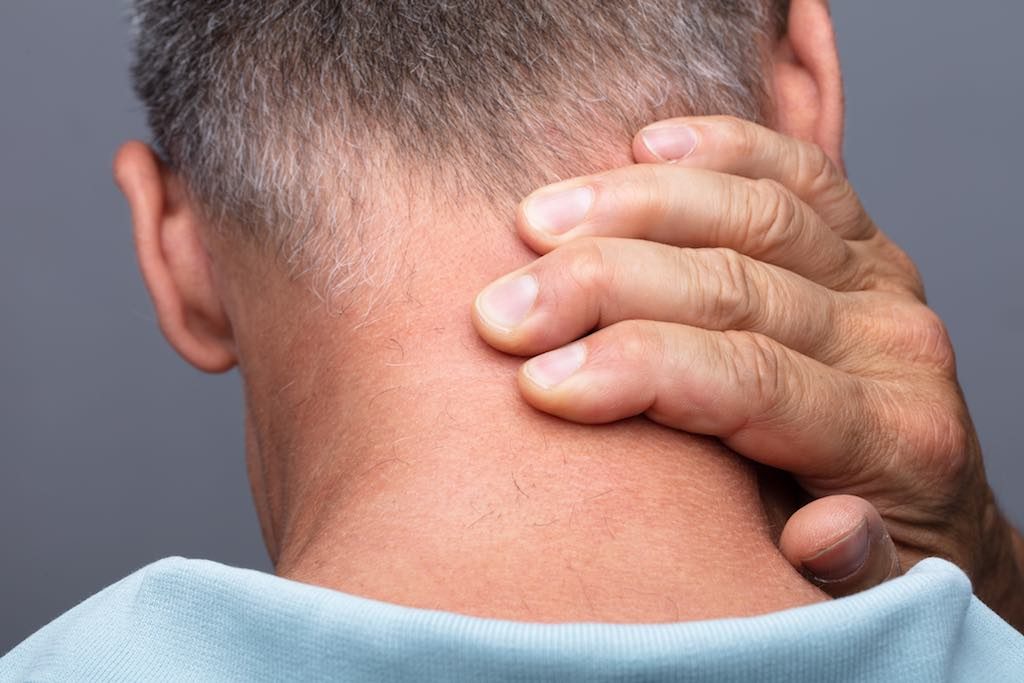
Degeneration is Normal
Some degree of arthritis or degeneration is normal. There are different factors that may contribute to your level of degeneration in your joints.
- previous trauma may predispose to earlier degeneration
- posture affecting how much load certain joints take
- higher levels of physical
labour in your job - sedentary jobs that require long periods of sitting
Different Types of Arthritis
Normally when someone
The signs and symptoms of a wear and tear type arthritis vs. autoimmune tend to be quite different. Something a health care professional is normally able to pick up.
People often remember an older relative who may have had a more aggressive type of arthritis such as rheumatoid or ankylosing spondylitis that has caused a deformity in the joints, and worried they will end up like that when told they have arthritis.
It is important that you clarify which type of arthritis you have.
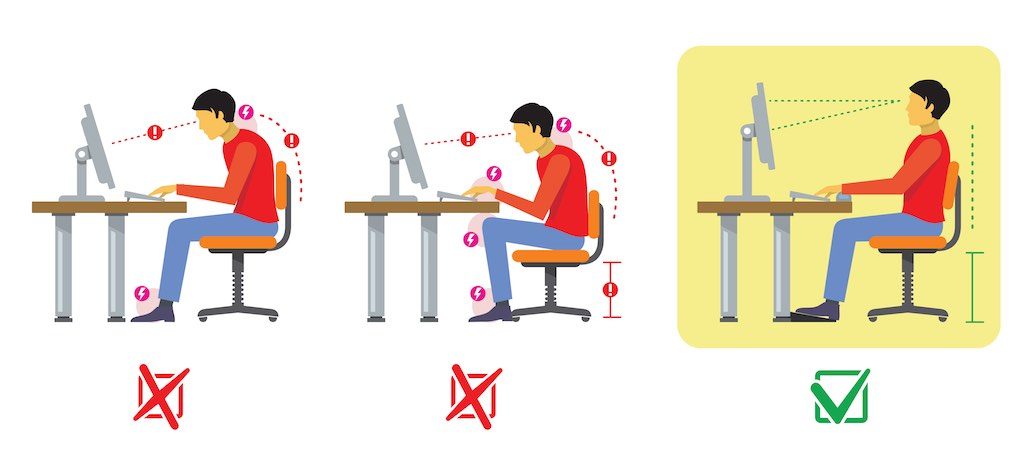
What You Can do to Help?
- Posture improvements. Download our OFFICE ERGONOMICS sheet.
- Stretch your neck regularly. Download our NECK STRETCHES sheet.
- Strengthen to improve your muscle endurance. You may want to seek professional advice around what strengthening exercises are best suited to your needs.
What Can an Osteopath or Chiropractor do?
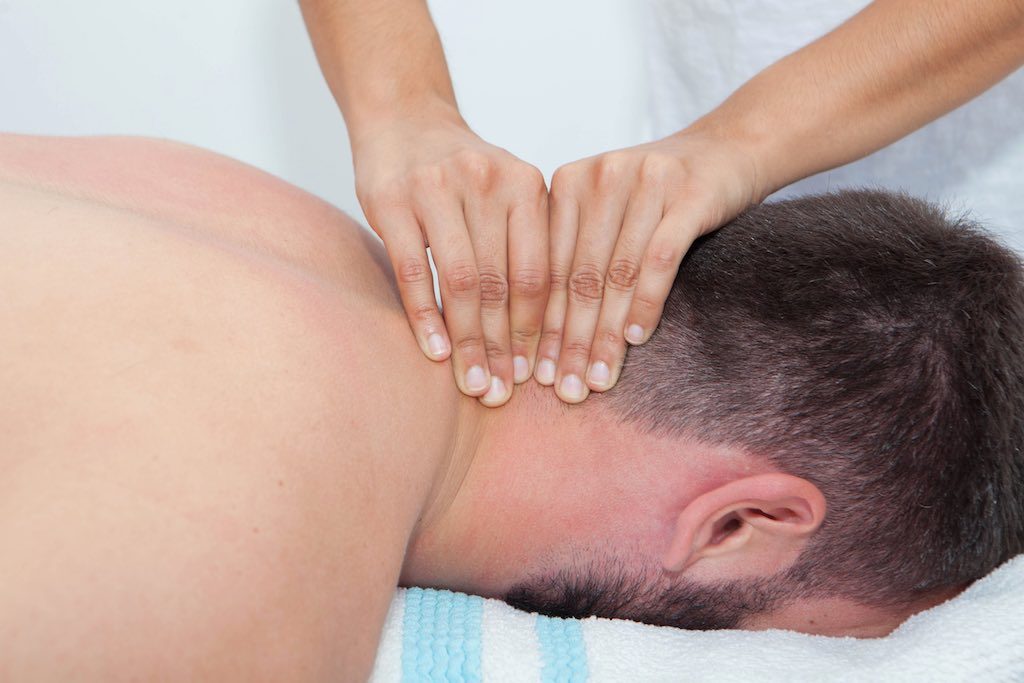
Osteopaths look at the whole body and not just your symptoms. We always go through a thorough history with you to determine the history behind your discomfort. Everyone experiences pain differently so we want to get your perspective on what is going on. We also go through past medical history and a general overview of your lifestyle to determine any underlying issues, and to educate you about beneficial changes.
We then examine the area to see how you move and how your muscles feel. At the same time, we can do certain testing to rule out any other issues that may be contributing to your neck pain.
So if you have neck pain, it's important to address the front and back of your neck, as well as all areas related ie:
- Shoulders
- Chest
- Upper back
- Pelvic and hip posture and alignment
- General core activation and endurance
- Overall posture
- Ergonomics
You can see there is more than just focusing on where you have discomfort.
Treatment Often Involves:
hands on soft-tissue massage work- cupping or dry needling
- gentle joint articulation
- joint manipulations if it determined to be safe and beneficial for your condition
- prescriptive stretches and exercises to help maintain you between treatment
How Often Do you Need Treatment?
It varies between individuals but our general aim is to reduce or resolve pain as much as possible. If you have had the discomfort for months or years we can still help reasonably quickly.
As your symptoms improve and pain diminishes we aim to spread your treatments out as much as possible. This may require you to keep up with regular stretches or exercises in between.
Once you feel easier movement and less discomfort you're usually in a better headspace to take on postural advice and start to make necessary lifestyle changes to avoid further stress or load to your joints.
Chiropractor Or Osteopath: Who Should You See?
Either! At Metamed we have both chiropractic and osteopathic practitioners that provide very similar treatments. Both are experienced in anatomy and know the spine well. You’re in safe hands with both chiropractors and osteopaths at Metamed.
Frequently Asked Questions
Differences Between An Osteopath And A Chiropractor?
Every practitioner treats differently. Each and every osteopath will be different, as well as each and every chiropractor. It’s really about trying different people and seeing what approach works best for you. After completing our training at university, every practitioner has to complete Continued Professional Development courses, allowing them to diversify and specialise in different areas. At Metamed, we use functional movement, acupuncture, emotional anatomy and herbalist advice on top of our skills as osteopaths or chiropractors.
Often appointment times differ between clinics, at Metamed our initial appointment is 1 hr and follow up appointments are 30mins, providing us with ample time to get to know you and your issue and treat accordingly. These appointment times are the same for all of our practitioners.
Can neck pain be a sign of something serious?
Generally no. Our team is trained in being able to identify any serious signs and symptoms and can refer on to your GP if need be.
Can osteopathy help trapped nerve?
Yes! Definitely! Trapped nerves are a result of narrowing vertebral disc space or lesions that have built up around where the nerve exits the spine.
References:
- Ministry of Health https://healthcentral.nz/latest-statistics-indicate-more-kiwis-living-with-arthritis/
The post Arthritic Neck: Chiropractor or Osteopath for neck pain appeared first on MetaMed.
]]>The post Osteopathy: The Migraine Solution appeared first on MetaMed.
]]>Who Is Affected?
Most common in the 25 to 55 age range, it also affects children where it’s often undiagnosed. Females experience migraines at a higher rate than males. The effects can be devastating to sufferers. Depression, anxiety, sleep problems, and dependence on medication are common results of regular migraine episodes.
The good news is, Osteopathy treatment can effectively treat headaches presenting as migraines and if you do suffer true migraines treatment may still be effective in reducing the intensity and / or frequency of your migraines. Often a change is felt within the 1 – 3 treatments. Read on to learn more about headaches versus migraines.
What is a Migraine and How is it Different From a Headache?
There are subtle differences between headaches and migraines see if you can identify which ones you are experiencing.
Migraines
Migraines can last for days. Sensitivity to light and noise is a common symptom of migraines. The pain is generally felt on one side of the head, it can sometimes feel as if the face is perfectly divided in half. Sufferers often feel the sensation of their heartbeat pulsating in their heads.
Physical activity may increase the pain and migraines can induce nausea and vomiting in sufferers.
There are four typical stages of a migraine:
- Prodrome – symptoms or changes experienced a day or two before a migraine. Symptoms include changes in bowel habits such as constipation and diarrhea, irritability, restlessness, sleepiness, and food cravings.
- Aura – typically last anywhere between 10-30 minutes. Usually visual symptoms but can also be motor or sensory. Visual symptoms can be ‘sparkly’ vision, flashes, floaters, double vision, loss of peripheral vision/tunnel vision. Others may feel tingling or sensory changes in different parts of their body including numbness, prickling that may affect arm, leg or the face, or transient muscle weakness or speech difficulties.
- Migraine – Can last hours to days. This is the symptoms of intense headache type sensations (stabbing, pounding, aching etc…) that usually leave people unable to function. They may experience photophobia- inability to be in the light, auditory sensitivity- difficulty with noises, nausea and vomiting.
- Postdrome – this can last for days after a migraine and may be experienced as feeling where the ‘headache’ was, feeling drained and washed out.
Not all four stages are identified by migraine sufferers but many will experience an ‘aura’ before the onset of migraine. They often use this as a warning to use medication before it gets too severe or that they need to go home and rest. Migraines can also be worsened in females by hormonal changes.
Some migraines can be severe and unresponsive to over the counter medications. If you have tried Osteopathy treatment, supplements and over the counter medications unsuccessfully your doctor can investigate further and prescribe migraine prophylaxis/prevention and treatment medication.
Headaches
Headaches are the result of tension in the neck or head. The pain is moderate and won’t impact on your daily life in the same way as a migraine headache will. Tight muscles in the shoulders, neck and jaw can become so tight that they start to refer pain causing the headache. In some cases, the pain can be so intense that it can present like a migraine including nausea and vomiting.
Types of Headaches:
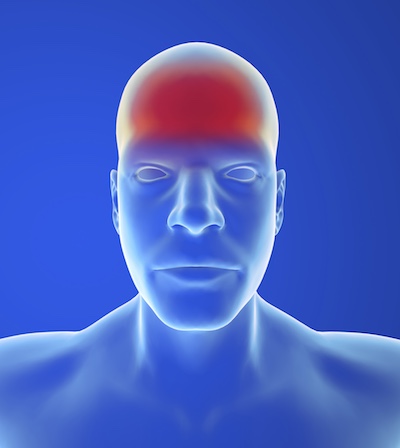
Tension: Dull aching sensation at the back of your neck, shoulders and scalp. Pain typcially occurs at the same time each day and aggravated by stress, relieved by alcohol.
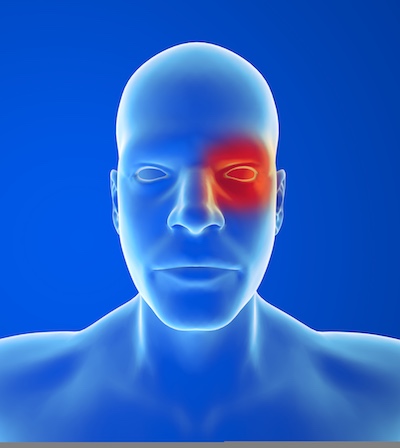
Cluster: Sharp piercing pain usually one-sided and behind the eye. Can have associated symptoms of nasal congestion, tearing of the eye, flushing or sweats on the affected side. Cluster headaches often come in regular bursts lasting 15 minutes to 3 hours. Usually occur at the same time each day. These types of headaches are more common in men.
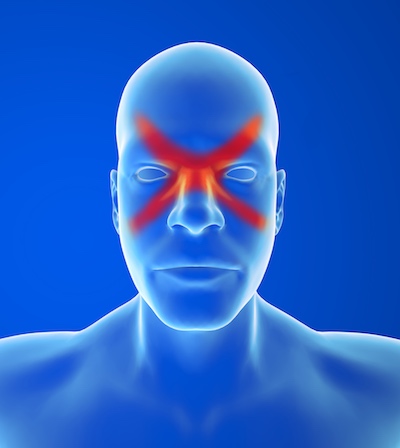
Sinus headaches: can be caused by congestion or infection of your sinuses. Pain and swelling can be experienced at the front of your cheeks by your nose where your maxillary sinuses are located, or pain between and above your brow where your frontal sinuses are located.
Where is your headache coming from?
- Base of the skull/suboccipital headache suboccipital muscle tension will typically give the heavy feeling at the back of the neck, if tight enough will radiate over the top of the head into the forehead and sometimes behind the eye
- Retro-orbital/behind the eye headaches– when you feel like someone is inside your skull stabbing you with a knife. You hold your hand over your eye or press under your brow the relieve the pain. These can be caused by a combination of neck muscle tension, and typically the sternocleidomastoid and scalene muscles at the front of the neck.
- Sharp and shooting pain that catches you when you turn your neck. There is a nerve called the greater occipital nerve that sits under the base of the skull. Sometimes muscle tension or irritation can cause irritability of the nerve. Turning the head into certain positions can aggravate it causing the sharp shooting pain.
- Hormonal headaches- typically cyclical or monthly and occur at the same time of your cycle. This can be ovulation, the week before your period or one week after.
- Dental pain- can cause sinus-like headaches in the cheek and temple region. Headaches are also common after dental work when your mouth has been open for a prolonged period of time (Temporomandibular joint TMJ pain) such as with orthodontic work, filling or crown work, root canals. Dental pain from wisdom teeth is also a common cause of headaches.
- Eye strain- straining to focus can overwork muscles controlling your eyes causing tension in pain. Often looking at a computer screen for long periods can lead to issues with your vision. Other symptoms of eye strain can be a sore neck and shoulders, watering eyes, blurry vision and difficulty concentrating. Eye strain can be made worse by stress and fatigue. We recommend you see an optometrist to have your eyes checked to see if it is the cause of your headaches.
What Causes a Migraine?
Both migraines and headaches can be triggered by stress. The list of causes of pain in the head and neck is extensive. But these are the most common ones:
- Head or neck trauma
- Muscle tension
- Nervousness & anxiety
- Irritated nerves
- Hormonal changes
- Depression
How Osteopathy Helps Migraine Pain?
Many people are concerned with the regular use of medication for pain. The potential side effects of migraine drugs are why complementary therapies are experiencing a rise in popularity.
Osteopaths use a holistic approach to treating pain. Headaches can have more than one cause so it’s important to treat each one. Physical and psychological issues trigger pain symptoms so it’s important to eliminate or treat all potential contributing factors. Osteopaths take into consideration all facets and help you to increase your awareness of aggravating factors so that you can make appropriate changes.
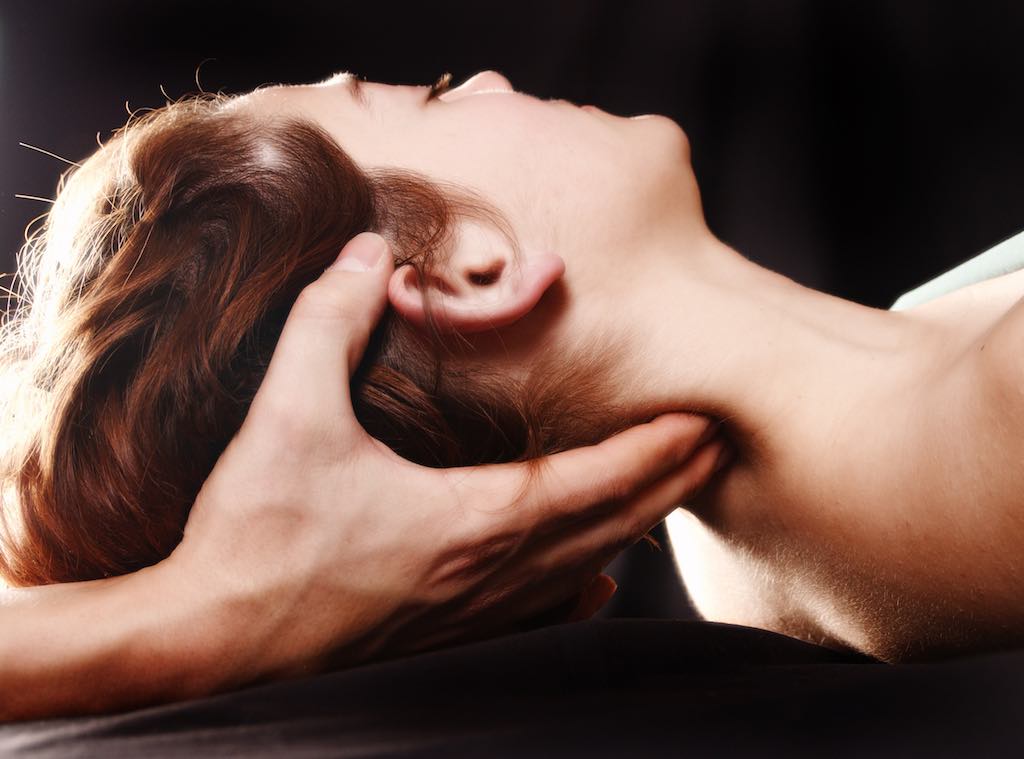
How Does an Osteopath Treat Migraines?
Osteopaths use hands-on manual techniques to relieve tension. Improving the natural range of motion of a joint, and relaxing muscles are effective in relieving pain and improving blood flow.
- Myofascial release techniques involve techniques that break up the knots in muscles that may be contributing to your headaches and migraines.
- Muscle release soft tissue massage will help to correct imbalances in the body caused by the work environment, injury, and bad posture.
- Manipulative therapies that help to mobilise joints from gentle articulation and stretching of joints and ligaments to more specific joint manipulations where you hear an audible release or ‘crack’ from the joint
- Cranial treatment a gentle treatment which is sometimes used in combination with the above direct treatment modalities. Often involves gentle contact with the head or sacrum (tailbone). Select Osteopaths at our clinic provide this treatment see Our Team for more information.
- Postural and exercise education Your posture can keep the cycle of muscle tension going. To break the cycle you will often be taught how your posture can change and exercises will help support better use of your muscles.

Natural Remedies for Migraines.
Supplements are usually recommended to support manual therapy. Often significant changes occur with treatment so we treat first. Supplements may be introduced if required to help regulate or normalize other contributing factors for longer term relief. If you are on any other prescription or herbal medication it is best you consult a Naturopath or herbalist for advice.
- Magnesium: A good quality magnesium citrate of magnesium diglycinate can help relieve nervous and muscle tension and induce relaxation. It can also help with cramps and a soothing night sleep. 300 mg – 600 mg of magnesium one hour before bed is recommended.
- Feverfew: Feverfew is a herb traditionally used as a prophylaxis for migraines. A daily dose of 25 mg – 30 mg is recommended and often comes in tablet form. But can be available in liquid form and prescribed with a combination of other herbs to help alleviate your symptoms. It is recommended you consult a Naturopath or herbalist.
- Vitex: Vitex is great at helping to normalize female hormones especially after coming off the pill. It acts on the pituitary gland to normalize progesterone production, a calming hormone. 1000mg daily in the morning. Allow 3 – 6 months for changes to occur. It is recommended you consult a Naturopath or herbalist.
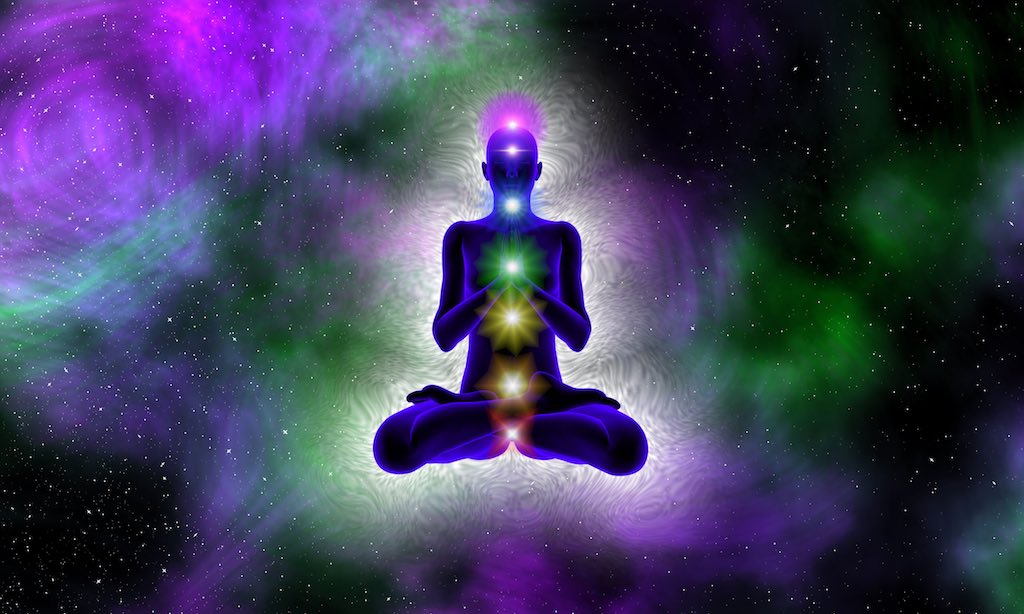
Psychosomatic Interpretation of Migraines
Inna Segal's book The Secret Language of the Body describes emotions behind different body parts and conditions. See if you can relate to any of the below, acknowledgement of what may be holding you back can help you to move forward:
Migraine: Control, pressure, seriousness, perfectionism. Overcommitting yourself. Great need for love and approval. Ignoring your own needs. Putting other people before you. Extreme guilt and anxiety. Conflict with self and other people. Self-punishment. Feeling angry and annoyed with others – ‘You are giving me a headache'
Root Cause Treatment
The aim of osteopathy for migraine treatments is to prevent further occurrence of pain. Osteopaths focus on finding and treating the root cause rather than focusing on temporary solutions. Of course, when you’re in pain, a quick solution is welcomed. Your Osteopath will help reduce or even eliminate the pain but they will also try to find the underlying causes. If necessary further referral to other practitioners such as Naturopaths or GPs can be organised.
Migraines are considered a vascular headache – the abnormal behaviour of blood vessels in the brain area can result in severe pain. An increase in blood supply to the head can cause pressure on the brain and the body’s reaction to this pressure causes pain. However, muscular tension in the neck, face, and head areas contribute to tension headaches, which in turn can stimulate migraines.
Poor posture restricts blood flow and lymph flow. Tension affects oxygen delivery and the result is a less than optimal waste removal system.
Your Osteopath’s main concern will be the root cause of the problem. Listening to your body is paramount. Understanding what is happening to your body that triggers migraines will help you deal with the problem, something drugs and medication will not do.
Osteopathy helps treat migraines in the following ways:
- Improves blood and lymph flow to the head and neck areas by removing blockages.
- Relieves migraine-triggering tension in the body.
- Helps relieve and prevent muscle spasms
- Mobilises restricted joints and normalises nerve function
Other treatment options
We always recommend trying a few sessions of physical therapy first. If there is no change your practitioner may recommend seeing other practitioners such as your GP, Naturopath or other therapists.
- seeing your Naturopath for further testing for possible food sensitivities and intolerances or hormonal imbalances
- a dentist to check your teeth for holes, infection or the state of your wisdom teeth
- hypnotherapy to help rewire behavioural patterns like stress
- Optometrist to check your vision
- your GP for medications that can help with vascular changes associated with migraines
The post Osteopathy: The Migraine Solution appeared first on MetaMed.
]]>The post Why my Jaw Hurts and What treatment can Help. appeared first on MetaMed.
]]>What does the TMJ do?
The TMJ joint is a hinge joint with a small disc within the joint. It connects the jaw (mandible) to the skull. Small muscles that help us chew (masticatory muscles) also help to open and closes your lower jaw. The TMJ allows us to:
- Speak
- Eat and chew
- Make facial expressions
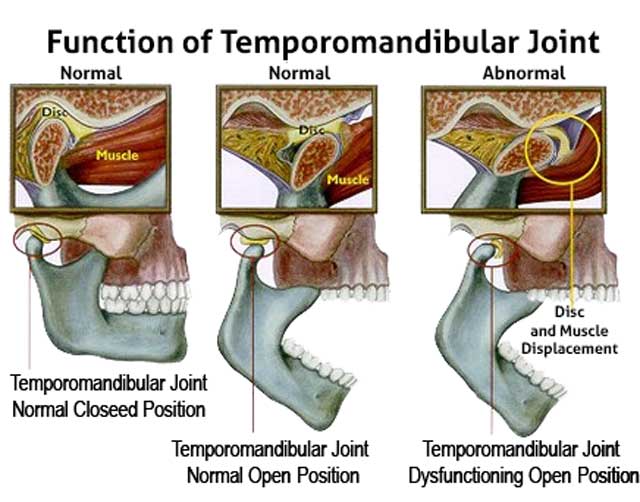
What causes pain in the jaw?
Some of these symptoms can be due to structural problems like tight muscles or an injury where the jaw was traumatised by impacts, such as getting kicked in soccer, falling over and knocking your chin, or dental procedures which may leave you to chew on one side of the mouth, or have your mouth open for a prolonged amount of time, even chewing gum too much can cause TMJ dysfunction. Other times the root cause may be emotional stress, nutrient deficiencies, and postural issues. Some patients who have autoimmune arthritic disorders like rheumatoid arthritis may be predisposed to having their TMJ affected.
Who is affected?
- Both men and women can be affected but women tend to experience issues with the jaw more than men
- Recent accident- this includes injury to the head as well as anywhere else in the body
- Recent dental work– wisdom teeth extraction, crowns, root canals or fillings
- Postural issues: poor posture, holding the phone between the ear and shoulder, leaning on your chin on your hand
- Those affected by autoimmune arthritis or have a family history of arthritis
- Recent surgery where intubation has been required
- Scuba divers due to the mouthpiece of your breathing apparatus
- Hormones and hormone replacement therapy may also play a role in TMJ dysfunction
Some common symptoms of TMJ dysfunction
When the TMJ is affected by pain or injury these two pretty mundane tasks can become awkward and painful.
- Locking of the jaw: locking open or jamming shut
- Not able to clench down on your back molars
- Pain and tenderness in the jaw at rest or whilst chewing
- Clicking
- Grinding sounds (crepitus)
- The jaw not tracking evenly when opening
- Difficulty speaking because your jaw won't open enough
- Difficulty eating and chewing or pain after eating hard foods
- Pain yawning
- Grinding the teeth at night (bruxism)
- Constant clenching of the jaw leading to a bulking of the muscles at the side of your cheeks
- Pain after dental work where you've had your jaw open for a prolonged period of time
The jaw can also refer pain elsewhere. Here's how else your TMJ pain may present:
- TMJ headaches and migraines particularly around the cheek and eye- dull, sharp or stabbing pain
- Inner ear pain
- The sensation of a blocked ear
- Sinus issues
- A toothache
- Pain around the base of the skull and front of the neck
- Pain on swallowing
- Dint marks from your molars on the sides of your tongue
- Ringing in the ears like tinnitus
- Dizziness
- Avoiding eating hard foods due to pain on chewing
- Wearing down of your teeth
- Waking with a sore face in the morning due to clenching or bruxism
- Pressure and pain in the base of the skull after orgasm- post-coital headache
What will your practitioner look at?
Our practitioners always consider the jaw with any head, neck and shoulder pain and vice-versa. Releasing the jaw can result in a huge amount of relief from chronic pain in these areas. But how do we treat it?
First, we need to assess the real cause of your jaw dysfunction. We'll go through a thorough history including asking you about any aches and pains you may experience anywhere in your body, including down to your toes. Every part of the body relates to one another. Any injuries that may have been sustained to the head, neck, and jaw itself and what exactly happened. Or was there another injury elsewhere that set your jaw pain off?
We also need to go through your past medical and family history this can give an indication if you are at risk of developing arthritis that may affect the jaw. Questions about your current stress are also very important and we find that this is often a cause for clenching and grinding the teeth.
We always have a look at how you are opening and closing your jaw to see how it tracks. Does it open smoothly in a straight line, or does it list left and right? Do you need to ‘unlock' your jaw to open it wider? Can you clench the back of your teeth together, and how does this feel? Are your muscles around your jaw and temples activating, are they tight or tender? Are there any sounds like crunching, popping or clunking when you open and close your jaw? Then we have a look at all the surrounding structures like your neck motion, shoulder range and even how you move through your lower back, hips, knees, and ankles.
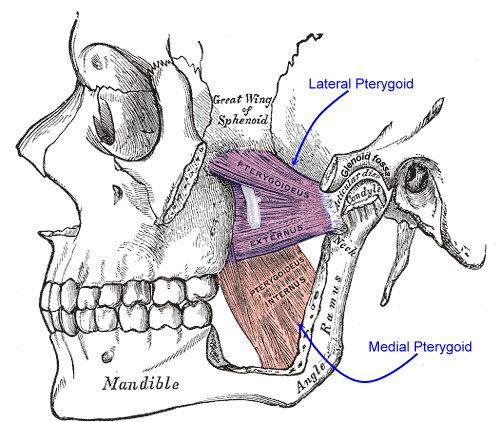
TMJ relief
There are many muscles that attach to the jaw and down to the neck through the front and at the back of the neck. Sometimes in response to the jaw being dysfunctional, these will develop trigger points. Trigger points are like tight bands or knots of muscle if tight enough they can produce pain when not in use and even send pain to a distant site. This is why you might feel ear pain, neck pain, and headaches if your jaw is not functioning properly. There are a few muscles on the inside of the jaw which aren't very accessible unless you actually get inside your jaw. That's why they often don't get treated. These are known as the medial and lateral pterygoids and help draw the hinge of the jaw forward and down articulating the disc smoothly inside the joint. If these are tight and not firing correctly this is where the disc can sometimes get caught and moves noisily within the joint.
We'll also assess your breathing and ask you about emotional stress as these issues can be a common trigger for jaw related issues.
Treatment may involve:
- Working on all the supporting musculature that directly relates to your jaw- head neck and shoulders
- Working inside your mouth with a gloved hand
- Treating the muscles around the face and head
- Treating the front and back of the neck and upper back
- Education about how you can help yourself between treatments- postural advice, eating soft foods, avoiding opening your jaw to its full range until it has settled, relaxation and breathing techniques
- You will be given a tailored TMJ exercise program to address issues in your jaw and neck function
We use a range of techniques including Osteopathy and Holistic Chiropractic deep soft tissue work, internal jaw releases using a gloved hand, joint mobilisations if necessary and dry needling. An experienced practitioner can use dry needling to release the facial muscles and muscles of mastication. Sound knowledge of underlying structures is important as nerves, vessels and glands traverse the TMJ.
Home remedies to help jaw pain
If you'd like to see if you can help your jaw before seeking treatment, here are a few tips you can try at home.
1. Become aware of the position of your jaw throughout the day. Take note of what it's doing if you get stressed, rushed or in an argument. Are you clenching without realising? The ideal resting position of the jaw is:
- Mouth closed
- Teeth slightly apart
- Tongue gently rests on the roof of your mouth
2. Gentle stretches to the neck and shoulders. Download our BASIC NECK STRETCHES.
3. Massage around the temples (next to the eye and into the scalp) and sides of the jaw
4. Eat soft foods and chew them gently on both sides of the mouth. Avoid eating things like apples, carrot, tough meat etc…
5. When you yawn support your lower jaw by applying gentle pressure to push the chin back as you yawn.
6. Take a high-quality magnesium supplement. New Zealand soils are deficient in magnesium so often we are too. Magnesium can help with muscle soreness, cramping as well and improving sleep.
7. Be aware of your breathing, altered breathing patterns are often triggered by stress, before we know it we adopt bad habits and do this unconsciously. Poor breathing can affect our ability to recover from stress, repair from trauma, sleep, immunity and energy levels. Ideally when you breathe at rest your belly rises and your chest stays still. Sometimes breathing properly takes more than just thinking about it. If you're having difficulty breathing properly there is a great online course by Physiotherapist and Wellness Architect Emma Ferris from the Butterfly Effect. Click here to find out more and get the first 5 days free.
8. Meditation and mindfulness can be very useful if you experience stress and anxiety. Again practising this on your own can be difficult some apps we recommend are Headspace and Calm.

Psychosomatic interpretation of jaw pain:
We're big on psychosomatics and mind-body connection and the underlying emotion that may be maintaining pain and discomfort in the body. So what can the jaw indicate? The jaw relates to the solar plexus which governs emotions around identity, confidence, self-esteem and trust. The other main area of the solar plexus is represented around the stomach region from the lower ribs to the belly button. This is also where you find your main breathing muscle- the diaphragm. When the jaw is affected it can relate to emotions around expression of yourself, an inability to speak up and stand up for yourself, fear of sharing what you're passionate about because you're worried what people will think, difficulty communicating your wants and needs, holding onto stress and anger. See if you can relate to any of these as acknowledging the role emotions play in how your physical body feels is an important part of healing. Treatment can help facilitate the release of these emotions. You may find that when having the jaw treated it is a highly emotional spot triggering anger, heat and tears. Releasing these emotional tensions can be a huge relief and be the start to a pain free jaw.
Other treatment options.
We always recommend trying a few sessions of physical therapy first. If there is no change your practitioner may recommend seeing other practitioners such as your GP, dentist, ear-nose and throat (ENT) specialist to rule out pain coming from other areas such as your sinus or teeth. If you've addressed other factors like sleep, stress and breathing there are a few other options available. These include:
- seeing your GP for help with relaxant type medications
- a dentist can make a splint that you wear at night
- hypnotherapy to help rewire behavioural patterns like stress
- some specialists inject botox into the muscles to force the muscles around the jaw to relax
- in intractable cases TMJ surgery is an option by an orofacial surgeon
If you are experiencing jaw issues or think that your symptoms are related to the jaw our practitioners are experienced treating this complex joint. For treatment of jaw pain in Wanaka and Queenstown.
The post Why my Jaw Hurts and What treatment can Help. appeared first on MetaMed.
]]>